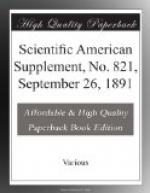Discarding copper, it has been proposed to substitute
steel or iron. In the early days of the higher
pressures, Mr. Alexander Taylor adopted wrought iron
for steam pipes. One fitted in the Claremont in
February, 1882, was recently removed from the vessel
for experimental purposes, and was reported upon by
Mr. Magnus Sandison in a paper read before the Northeast
Coast Institution of Engineers and Shipbuilders.[2]
The following is a summary of the facts. The pipe
was 5 inches external diameter, and 0.375 inch thick.
It was lap welded in the works of Messrs. A. & J.
Stewart. The flanges were screwed on and brazed
externally. The pipe was not lagged or protected
in any manner. After eight and a half years’
service the metal measured where cut 0.32 and 0.375
inch in thickness, showing that the wasting during
that time had been very slight. The interior
surface of the tube exhibited no signs of pitting
or corrosion. It was covered by a thin crust of
black oxide, the maximum thickness of which did not
exceed 1/32 inch. Where the deposit was thickest
it was curiously striated by the action of the steam.
On the scale being removed, the original bloom on
the surface of the metal was exposed. It would
thus appear that the danger from corrosion of iron
steam pipes is not borne out in their actual use; and
hence so much of the way is cleared for a stronger
and more reliable material than copper. So far
the source of danger seems to be in the weld, which
would be inadmissible in larger pipes; but there is
no reason why these should not be lapped and riveted.
There seems, however, a more promising way out of
the difficulty in the Mannesmann steel tubes which
are now being “spun” out of solid bars,
so as to form weldless tubes.
[Footnote 2: Transactions Northeast Coast Institution of Engineers and Shipbuilders, vol. 7, 1890-91, p. 179.]
Table I.—Tensile strength of gun metal at high temperatures.
--------------+------------+-------------+-------------
+------------+ | | | | | Composition |Temperature | Tensile | Elastic | Elongation | of | of oil | strength | limit | in | gun metal. | bath. | per square | per square | length of | | | inch. | inch. | 2 inches | --------------+------------+-------------+-------------+----
--------+ Per cent. | Fahr. | Tons | Tons | Per cent. | Copper 87 /| 50 deg. | 12.34 | 8.38 | 14.64 | Tin 8 / | | | | | Zinc 31/2 \ | | | | | Lead 11/2 \| 400 deg. | 10.83 | 6.30 | 11.79 | --------------+------------+-------------+-------------+----
--------+ Copper 87 /| 50 deg. | 13.86 | 8.33 | 20.30 | Tin 8 { | | | | |




